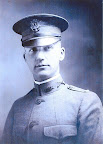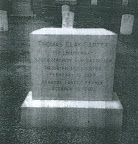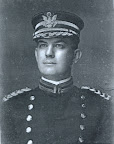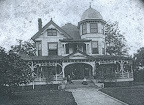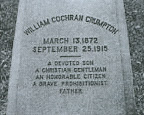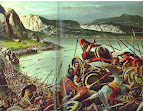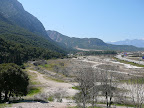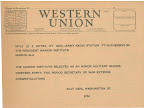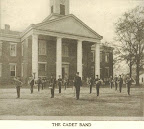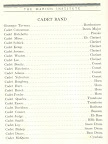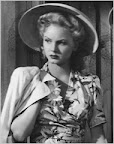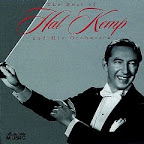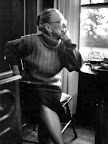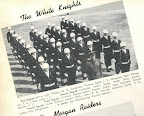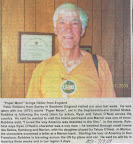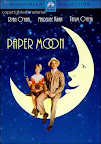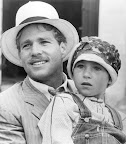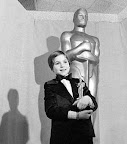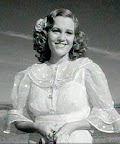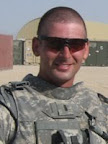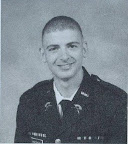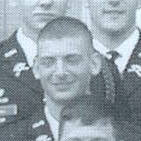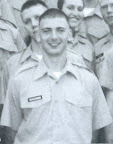
A scene from The Horse Soldiers movie (1959).
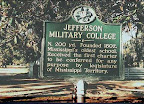
Mississippi state historical marker for Jefferson Military College in Washington. It served as Jefferson Military Academy in The Horse Soldiers. (Credit: www.ssrc.msstate.edu/grr/adamshm.html)
Besides being a classic John Ford-John Wayne motion picture, many Civil War enthusiasts consider The Horse Soldiers (1959) to be the quintessential Hollywood movie depicting the epic struggle between the North and South. Directed by John Ford, and starring John Wayne, William Holden, and Constance Towers, the screenplay is loosely based on both Colonel Benjamin Grierson’s raid in 1863 through Mississippi, and on the novel, The Horse Soldiers, by Harold Sinclair.
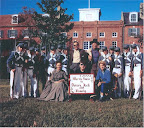
Merry Christmas 1958 from some of the cast/crew of The Horse Soldiers. With cadets at JMA are Hollywood actors/director (L-R, sitting/kneeling) Anna Lee, director John Ford, and Constance Towers. Standing (L-R) are William Holden and John Wayne. (Credit: John Oye and United Artists)
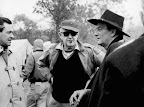
On the set (L-R): William Holden, John Ford, and John Wayne.
A poignant and entertaining scene in the movie is the charge of the cadet corps of Jefferson Military Academy in Washington, Mississippi, a scene inspired by the charge of the Virginia Military Institute cadets at New Market, Virginia, on May 15, 1864. The Jefferson cadets, ranging in age from nine to sixteen, are led by their aged, lame, Reverend-Superintendent, played by veteran actor Basil Ruysdael, who walks with a cane in one hand and the Holy Bible in the other. The charge never actually happened, however; the school was closed in 1863, when occupied by Union forces. Jefferson Military Academy is not even mentioned in the novel. Scenes for the movie were embellished: for example, while Grierson’s raiders actually destroyed the railroad and supply depot at Newton Station, Mississippi, the scene where the Confederates detrain and charge down the street to their total destruction, never occurred. The producers decided to include the cadet sequence as a tribute to the Virginia Military Institute, and the scenes provide both a humorous and heartrending diversion for the movie viewer. The charge of the Jefferson Military Academy cadets was filmed on a farm outside of Natchez.
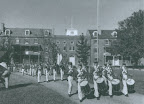
Marching off to war at Jefferson Military Academy.
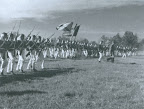
Advancing for the charge on the Union cavalry.
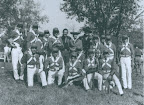
Another image with some cadets. (L-R, center, standing) William Holden, Constance Towers, and John Wayne.
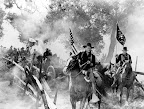
Scene after taking the Confederate battery at the bridge.
Incorporated by an act of the General Assembly of the Mississippi Territory in 1802, Jefferson College, named in honor of Thomas Jefferson, was the first institution of higher learning in Mississippi. Despite years of financial difficulties, Jefferson College opened its doors as a preparatory school in 1811, and became a full-fledged college in 1817, although it maintained its primary and secondary classes. Ten year-old Jefferson Davis, later president of the Confederacy, attended in 1818. Naturalist John James Audubon, who painted in the Natchez area, sent his sons to Jefferson College. The two most prominent buildings on campus, both built in the Federal architectural style, included the East Wing (1819) and the West Wing (1839). These were multi-purpose facilities which housed offices, classrooms and living space for both faculty and students. In 1830, the college purchased the nearby Methodist Church, site of the 1817 Mississippi statehood convention, for additional space. At the end of the Civil War, the Freedmen’s Bureau utilized the campus during the summer of 1865. By the fall of that year, the college’s Board of Trustees regained control of the school and managed to reopen Jefferson College in 1866. Becoming Jefferson Military College in 1893, the school was actually a military preparatory school. As was true with other American military preparatory schools, JMC attracted a number of cadets from Latin American countries. Jefferson Military College served the state and region well until declining enrollment closed its doors for good in 1964 - just six years after the filming of The Horse Soldiers in the fall of 1958. Jefferson College had operated as an educational institution from 1811 until 1964. It is now incorporated as Historic Jefferson College, an official Mississippi state historic site.
In addition to The Horse Soldiers (1959), several Hollywood movies and television programs have been filmed at Historic Jefferson College: Huckleberry Finn (1973), Mistress of Paradise (1981), North and South (the 1985 television mini-series whereby Jefferson College became the United States Military Academy at West Point), and The Adventures of Huckleberry Finn (1992).
Listed on the National Register of Historic Places, Historic Jefferson College is administered by the Mississippi Department of Archives and History. Restoration projects, completed in 1977 and 1984, have returned the college’s façade to its antebellum appearance. These projects were partially funded by Friends of Jefferson College, a nonprofit corporation. Alumni, former faculty and staff, and friends of the school are organized as The Jefferson Military College Foundation.

Historic Jefferson College today in Washington, Mississippi. The campus has been restored to its antebellum appearance. (Credit: www.flickr.com)
MMI Family traveling in the area are encouraged to visit the historic campus on fabled US Highway 61 in Washington, Mississippi, just outside of Natchez. Also, check out their web site at http://www.jeffersonmilitarycollege.com/. Historic Jefferson College is truly an inspiring step back in time.
